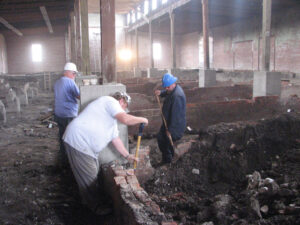
Deconstructing Salt & Soda with Robin Dupont
December 15, 2020
Sarah Griebel
February 26, 2021
“While many can lay claim to their part in the restoration of Medalta and the creation of the Historic Clay District, Darcey Howells best exemplified the heart of the project for almost a quarter of a century.
From the time he arrived on the site in 1994 for a short-term work project, until his retirement in 2017 as Construction & Site Superintendent, Darcey was responsible for and had intimate knowledge of every nail, board, window, and roof throughout the ever expanding site.
 Initially, he took charge of a small group of labourers cleaning and preparing the deserted Hycroft China factory to open to the public as the new Medicine Hat Clay Industries Interpretive Centre. In Darcey’s own words, there were “piles of garbage all over the place… broken glass… broken moulds… broken windows up top… broken wood.” Could he get it ready for the May long weekend? “We’ll give it a try,” Darcey said.
Initially, he took charge of a small group of labourers cleaning and preparing the deserted Hycroft China factory to open to the public as the new Medicine Hat Clay Industries Interpretive Centre. In Darcey’s own words, there were “piles of garbage all over the place… broken glass… broken moulds… broken windows up top… broken wood.” Could he get it ready for the May long weekend? “We’ll give it a try,” Darcey said.
That was often his reply when tasked with a challenging project: “We’ll give it a try.”
And more often than not, he succeeded. Among his first tasks was the fabrication of Hycroft’s Great Wall of China – an undulating 72 foot long wall of chinaware. In its own right, it became a historic landmark.
With his team, he restored acres of roofs at both Hycroft and Medalta, rebuilt windows, constructed walls, floors and exhibits throughout the sites and oversaw the maintenance of all forms of equipment from ancient furnaces to complex modern heating systems. Whether he was digging out the foundation beneath the teetering structure of Building 12, the Turning Room, painting endless walls of white in Building 6, the Shaw Centre, or shoveling out from another snowfall, Darcey took it on.
 Almost nothing was beyond his effort. Perhaps the greatest test of his skills was overseeing the construction of Building 7. A structural steel building, rising two stories in some places, encompassing some 10,000 sq. ft. and enclosing an equal size events courtyard, it replaced a portion of a similar styled building which Darcey watched helplessly as it burned just 15 years before. Since completion, the Reception Gallery has become a popular gathering spot for weddings, concerts and celebrations of all sorts, thereby contributing significantly to the operation of the museum. Darcey took great pleasure in seeing people enjoy what he had built.
Almost nothing was beyond his effort. Perhaps the greatest test of his skills was overseeing the construction of Building 7. A structural steel building, rising two stories in some places, encompassing some 10,000 sq. ft. and enclosing an equal size events courtyard, it replaced a portion of a similar styled building which Darcey watched helplessly as it burned just 15 years before. Since completion, the Reception Gallery has become a popular gathering spot for weddings, concerts and celebrations of all sorts, thereby contributing significantly to the operation of the museum. Darcey took great pleasure in seeing people enjoy what he had built.
Years later, Darcey would admit that he thought Medalta was finished as he watched that fire rage in 1996. Time and time again, Medalta flirted with physical disaster. Four floods – in 1995, 2005, 2010 and 2013 – would put Darcey to the test, as did smaller acts of vandalism and a pesky fire alarm that would go off in the early hours of the morning. Many was the time that Darcey would give a spontaneous tour of Hycroft or Medalta to the responding fire or police crew, before heading home to bed, only to be back on the job by 7 a.m. the next morning.

Darcey never lost his love for Medalta and Hycroft, and the various projects throughout the Historic Clay District. He spoke with prideof the work being done by all the people who came there. While he was sometimes critical of those who saw it as just a job, he gave tremendous support to those who understood the value of what was being done to preserve and grow the District.
Darcey Howells shared the vision of Medalta and the Historic Clay District, but it was he who shouldered the bulk of the physical labour. If anyone truly deserved the right to say he built Medalta, it would be Darcey.”





